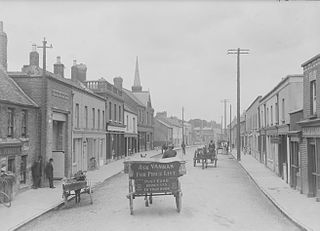
Rathfarnham is a southside suburb of Dublin, Ireland in County Dublin. It is south of Terenure, east of Templeogue, and is in the postal districts of Dublin 14 and 16. It is between the local government areas of Dún Laoghaire–Rathdown and South Dublin.

Knocklyon is a suburb of Dublin in county of South Dublin, within the old County Dublin, Ireland. A number of old cottages and farmhouses along Knocklyon Road attest to the area's rural past.

Whitechurch is a small suburban area on the south side of County Dublin, in the administrative county of South Dublin, situated south of Ballyboden, east of Edmondstown and west of Marlay Park. The greater part of the area lies north of the M50 semi-orbital motorway, with some remote parts merging into the mountainous districts of Tibradden and Kilmashogue south of the road, all at the foot of the Dublin mountains. Whitechurch is usually considered to lie within the greater Rathfarnham area.
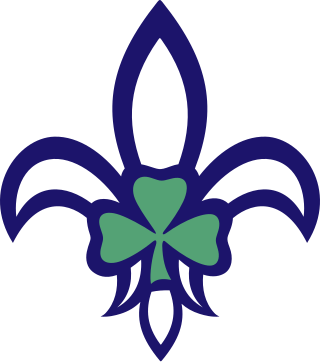
Scouting Ireland is one of the largest youth movements on the island of Ireland, a voluntary educational movement for young people with over 45,000 members, including over 11,000 adult volunteers early 2020. Of the 750,000 people between the ages of 6 and 18 in Ireland, over 6% are involved with the organisation. It was founded in 2004, following the amalgamation of two of the Scouting organisations on the island. It is the World Organization of the Scout Movement-recognised Scouting association in the Republic of Ireland. In Northern Ireland it operates alongside The Scout Association of the UK and the Baden-Powell Scout Association.

The Scout Association of Ireland (SAI; Irish: Cumann Gasógaíochta na hÉireann) was an Irish multi-denominational Scout association from 1908 until 2004, when it merged with the former Catholic Boy Scouts of Ireland to form Scouting Ireland. It was named "Scouting Ireland (SAI)" in the years leading up to the merger. The SAI was formed soon after the publication of Scouting for Boys and was affiliated to the British Boy Scout Association, which meant its members were mainly unionist and hence Protestant in background. After the 1920s partition of Ireland, the SAI remained organised in both the Republic of Ireland and Northern Ireland.
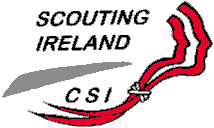
The Catholic Boy Scouts of Ireland (CBSI; Irish: Gasóga Caitliceacha na hÉireann) was an Irish Catholic Scouting organisation active from 1927 until 2004, when it formed Scouting Ireland by merging with the former Scout Association of Ireland (SAI), a non-denominational Scout organisation. The CBSI changed its name to "Catholic Scouts of Ireland" (CSI) when it admitted girls and to "Scouting Ireland (CSI)" in the run-up to the foundation of Scouting Ireland. It was active in both the Republic of Ireland and Northern Ireland.
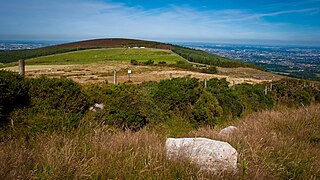
Kilmashogue or Kilmashoge is a mountain in Dún Laoghaire–Rathdown county in Ireland. It is 408 metres high and forms part of the group of hills in the Dublin Mountains which comprises Two Rock, Three Rock, Kilmashogue and Tibradden Mountains. The forest plantation on its northern slope, which is composed mainly of Sitka spruce, Scots pine and beech, is a habitat for Sika deer, hares, rabbits and foxes. A number of prehistoric monuments can be found on the slopes of the mountain.

Ballyboden is a locality within the suburb of Rathfarnham, County Dublin, at the foot of the Dublin Mountains between Whitechurch, Ballyroan and Knocklyon. It is in the local government area of South Dublin, and is a townland in the civil parish of Rathfarnham in the barony of Uppercross.
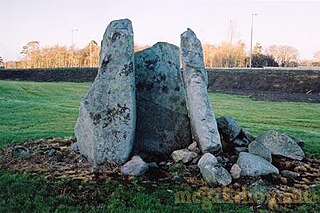
Brehon's Chair, sometimes Druid's Chair, is a megalithic site, and national monument, in Whitechurch, Rathfarnham, Dún Laoghaire–Rathdown, County Dublin, Ireland.
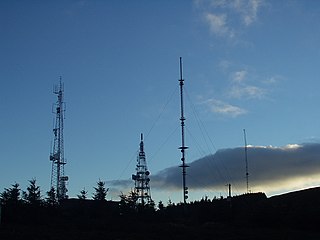
Three Rock Mountain is a mountain in Co Dublin, Ireland. It is 444 metres high and forms part of the group of hills in the Dublin Mountains which comprises Two Rock, Three Rock, Kilmashogue and Tibradden Mountains. The mountain takes its name from the three groups of granite rocks at the summit. It was once believed that these features were man-made: for instance, Gabriel Beranger wrote of them in 1780, "I take them to be altars upon which sacrifices were offered […] the regularity which is observed in piling them convinces me they are the work of man, as they could not grow in that position". In fact, the three outcrops are tors: natural geological features produced by the gradual process of weathering. Today, the summit is dominated by the many radio masts and towers that use the site to broadcast their signals across the Dublin area below. The forestry plantations on the slopes consist mainly of Sitka spruce, Japanese larch, Scots pine, Monterey pine and lodgepole pine.

Venture Scouts in Scouting Ireland are aged between 15 and 17 years of age. The awards scheme of Venture Scouts is called Rogha, an Irish word meaning Choice. Although many groups use Gaisce, the President's Award, as part of their programme also. Each group has a Venture Scout Executive which, under the guidance of an adult Scouter, designs and implements activities.

Scouts in Scouting Ireland are aged between 11 and a half to 16 years of age. Each group has a Court of Honour/Patrol Leader's Council which under the guidance of an adult Scouter designs and implements activities. Scouts is the section where activities begin to really challenge the youth member and impart responsibility and self-reliance in accordance with the Scout method and the educational philosophy of Baden-Powell. The organisation also currently has Sea Scout and Air Scout programmes. The highest award is the Chief Scout Award.

Tibradden Mountain is a mountain in County Dublin in the Republic of Ireland. Other former names for the mountain include "Garrycastle" and "Kilmainham Begg". It is 467 metres high and is the 561st-highest mountain in Ireland. It forms part of the group of hills in the Dublin Mountains which comprises Two Rock, Three Rock, Kilmashogue and Tibradden Mountains. The views from the summit encompass Dublin to the north, Two Rock to the east and the Wicklow Mountains to the south and west.
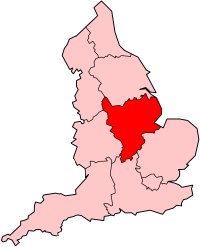
Scouting activities can be found throughout the English region of the East Midlands. The largest number of Scouts and volunteer leaders in the region is linked to the Scout Association of the United Kingdom, while there is also a presence of traditional Scouting groups, such as the Baden-Powell Scouts' Association. The Scout Association administers the region through five Scout Counties, overseen by a regional commissioner, which largely follow the boundaries of the ceremonial counties they exist within although in Lincolnshire the former Humberside county is still used. There are also a number of Scouting clubs within Universities in the region which are affiliated to the Student Scout and Guide Organisation. Scouting organisations at every level of the hierarchy also own and operate campsites and activity centres in the area for the benefit of Scouts, Guides and other youth groups.
Joseph B. Whelehan was an Irish politician, scout leader and teacher. He was born in Tyrrellspass, County Westmeath, the son of grocery shopkeeper Michael Whelehan and Jane Gavin. He was married in Tuam in April 1918 to Mary Philomena Waldron.
Stillorgan-Rathfarnham RFC is an Irish rugby team based in County Dublin. They play in the Leinster Metropolitan League. There are also teams playing at J4 and J5 standard. The club colours are maroon, white and navy and are sponsored by Ma Nolan's Bars in Nice France, PC Peripherals and The Dropping Well Bar and Restaurant in Milltown. In 2018 the club renamed from Stillorgan RFC to Stillorgan-Rathfarnham RFC as the club prepares to move into its new home at Tibradden Road, Rathfarnham. The development will include 3 playing pitches, floodlighting and a clubhouse. The grounds shall be known as Heavey Technology Park, to reflect the support and assistance provided by club member Michael Heavey throughout this process.
Sea Scouting has existed in Scouting Ireland and its predecessor associations since 1912. Sea Scout Groups are members of the World Organization of the Scout Movement (WOSM) through their membership of Scouting Ireland. Sea Scouting provides Scout training with and through water-borne activities.
The Miami Valley Council is a local council of the Boy Scouts of America and serves Darke, Preble, Miami, Shelby and Montgomery counties in Ohio.

The Dublin Mountains Way is a waymarked long-distance trail in the Dublin Mountains, Counties South Dublin and Dún Laoghaire–Rathdown, Ireland. The route is approximately 42 kilometres long and runs from Shankill in the east to Tallaght in the west. It has been developed by the Dublin Mountains Partnership, an umbrella group of relevant state agencies and recreational users working to improve recreational facilities in the Dublin Mountains.
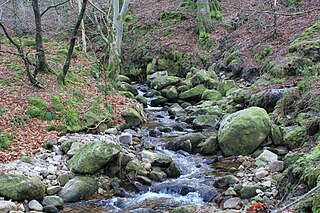
The Owendoher River is a small river in southern County Dublin, Ireland, the largest tributary of the River Dodder, and a part of the River Liffey system.



















